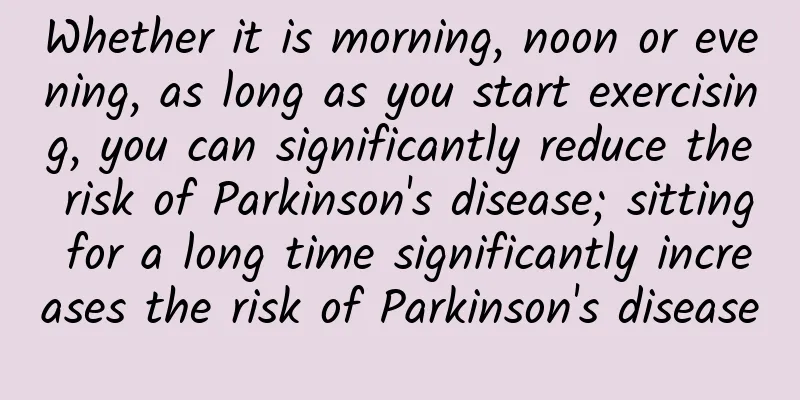Whether it is morning, noon or evening, as long as you start exercising, you can significantly reduce the risk of Parkinson's disease; sitting for a long time significantly increases the risk of Parkinson's disease

|
Parkinson's disease (PD) is the second most common neurodegenerative disease after Alzheimer's disease. Currently, there is no effective drug to prevent or delay neurodegeneration. Therefore, it is crucial to develop non-drug strategies (i.e., improving lifestyle) to prevent the occurrence of PD. Previous studies have shown that physical activity can reduce the risk of mortality and other neurodegenerative diseases, but the conclusions on the association between physical activity and PD risk are inconsistent. It is worth noting that previous studies have used self-reported questionnaires to assess physical activity, which has a certain degree of recall bias. In addition, self-reported questionnaires cannot accurately assess light-intensity physical activity (LPA). Therefore, although LPA is the main form of activity in daily life, there is limited evidence for the association between LPA and PD risk. In addition, almost all physiological and biochemical processes in the human body follow circadian rhythms, and no studies have evaluated the relationship between physical activity at different times of the day (morning, noon-afternoon, and evening) and PD risk. (Picture from the Internet, copyright belongs to the original author) In response to this problem, the National Clinical Research Center for Kidney Diseases of Nanfang Hospital has carried out relevant work, and the research results were recently published in the journal npj Digital Medicine . The study found that whether exercising in the morning, noon-afternoon, or evening, the longer the LPA or medium-to-high intensity physical activity (MVPA) measured by the accelerometer, the lower the risk of PD; and the longer the sitting time, the higher the risk of PD. Professor Qin Xianhui of the National Clinical Research Center for Kidney Diseases of Nanfang Hospital, Southern Medical University is the corresponding author of the article, and Dr. Liu Mengyi is the first author. The study included more than 90,000 middle-aged and elderly participants with accelerometer measurements from the UK Biobank study. The average age was 56.1 years (SD, 7.8). The average time for LPA, MVPA, and sedentary was 5.1 (SD, 1.6), 0.7 (SD, 0.6), and 9.4 (SD, 1.8) hours/day, respectively. After 6.8 years of follow-up, 313 (0.3%) participants developed PD. The study showed that: (1) The duration of LPA and MVPA showed an L-shaped correlation with the risk of PD, while the duration of sedentary time showed an inverse L-shaped correlation with the risk of PD. That is, as the LPA and MVPA time increased, the risk of PD decreased. When the LPA and MVPA time increased to a certain extent (LPA >3.89 hours/day, MVPA >0.27 hours/day), the risk of PD was the lowest and remained constant. When the sedentary time reached a certain extent (≥9.41 hours/day), the risk of PD increased linearly and continuously (Figure 1); Figure 1 Dose-response relationship between light-intensity physical activity (a), moderate-to-heavy-intensity physical activity (b), and sedentary time (c) and the risk of new-onset Parkinson's disease (2) When LPA and MVPA were considered simultaneously, high LPA and high MVPA were associated with an 87% lower risk of PD compared with low LPA and low MVPA. (3) When physical activity (LPA and MVPA) and sedentary time were considered simultaneously, low LPA and high sedentary time increased the risk of PD by 459% compared with high LPA and low sedentary time; low MVPA and high sedentary time increased the risk of PD by 293% compared with high MVPA and low sedentary time; (4) Similar results were found in the three time windows (morning, noon-afternoon, and evening). (Picture from the Internet, copyright belongs to the original author) Overall, this large-scale prospective study showed for the first time that regardless of when exercise was performed (morning, mid-afternoon, and evening), higher accelerometer-measured MVPA (≥0.27 hours/day) and LPA (≥3.89 hours/day) significantly reduced the risk of PD, while higher sedentary time (≥9.41 hours/day) significantly increased the risk of PD. As long as you move, it's good for your health! (Picture from the Internet, copyright belongs to the original author) Regardless of time, regardless of intensity, Stand up, Get moving. More energetic, Healthier! References: Liu M, Gan X, Ye Z, Zhang Y, He P, Zhou C, Yang S, Zhang Y, Qin Editor | Liu Mengyi and Zhang Yiwei Audit | Qin Xianhui Reprint: Please contact us and indicate the source Welcome to follow Kidney Health Promotion Study A small step in scientific communication is a big step in healthy living! Pay attention to the whole chain of kidney disease prevention and control strategies, share the latest research results and dynamics of the Kidney Health Promotion Research Group, open, cooperative, sharing, and win-win! Welcome everyone to subscribe, criticize and correct! |
<<: Evening Science | How strong is H5N1? Does China have a vaccine?
>>: Does “cancer constitution” really exist?
Recommend
Normal range of progesterone at eight weeks of pregnancy
Do you know the normal range of progesterone at e...
Is it good to have more menstruation?
The amount of menstrual blood during menstruation...
What is bilateral lobular hyperplasia?
Many women are very familiar with bilateral lobul...
Factors that cause women's right lower eyelid twitching
In daily life, people are under increasing pressu...
One month into pregnancy, I have morning sickness
After a successful pregnancy, various changes wil...
New Fudan study: The impact of low-dose CT screening on the diagnosis of lung cancer in women
With the advancement of medical technology, cance...
What are the reasons for delayed menstruation in women?
It is normal for a woman's period to be advan...
I bleed when I bump into something. Can this disease be prevented and treated?
When you are like a "paper-mache mud ball&qu...
At what age is menopause best for women?
The first menstruation is also called menarche, w...
What are the effects of endometriosis?
When women suffer from endometriosis, they must s...
How many days late is normal for menstruation?
Many friends will find that their menstruation is...
Our goal is to have no tooth decay
Creation and dissemination of oral science works ...
How to regulate and relieve Yin deficiency and excessive fire
Yin deficiency and hyperactivity of fire is mainl...
How to prevent hand, foot and mouth disease in spring?
As the weather gets warmer, hand, foot and mouth ...
How to relieve pain around nipple
The health of breast nipples is of great concern ...









